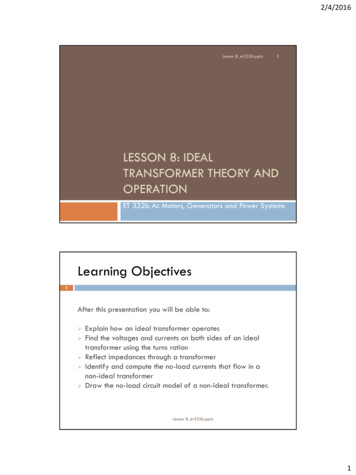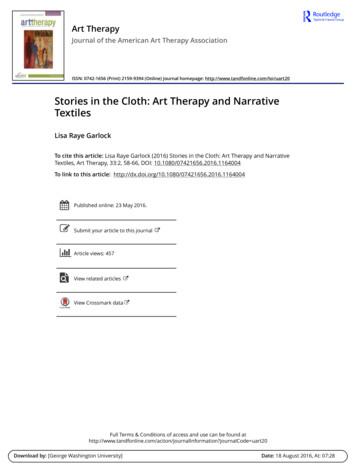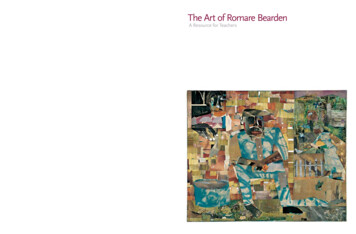![Linked Art Vocabs Itwg.pptx [Read-Only]](/img/23/newbury-sanderson-itwg-2017.jpg)
Transcription
Linked Art &IIIF: eLinked.Art & Vocabularies:Linked Open Usable DataRob Sanderson, David NewburySemantic Architect, Software & Data ArchitectJ. Paul Getty .edu@getty.edursanderson@getty.edu, dnewbury@getty.edu@azaroth42, @workergnome
Linked Art &IIIF: @getty.eduRDF &Linked Data &Ontologies &Vocabularies
Linked Art &IIIF: @getty.eduWhat is RDF?“RDF is a standard model for data interchange on the Web.” A way for computers to work with facts A way to express statements about resources A W3C (web‐based, web‐friendly) data standardSubject ‐ Predicate ‐ Object
Linked Art &IIIF: @getty.eduWhat is Linked Data?“The term Linked Data refers to a set of best practices forpublishing structured data on the Web.” Some rules that help make RDF useful for others Every ID is a HTTP URL, and it returns info about itself You should use other people’s URLs whenever you canSubject (URI) ‐ Predicate (URI) ‐ Object (URI)
Linked Art &IIIF: @getty.eduWhat are Ontologies?“The formal naming and definition of the types, propertiesand interrelationships of the entities that exist for aparticular domain.” The application of the LOD framework to a domain Ontologies provide meaning to data Ontologies are most useful when used by multipleorganizations and datasets
Linked Art &IIIF: @getty.eduCultural Heritage Ontologies?“The CIDOC‐CRM provides definitions and a formalstructure for describing the implicit and explicit conceptsand relationships used in cultural heritage documentation.” An event‐based way to look at the worldMature ontology in Museum domain”Semantic glue" between different information sourcesHighly theoretical
Linked Art &IIIF: @getty.eduWhat are Vocabularies?“A controlled vocabulary is an organized arrangement ofwords and phrases used to index content and/or retrievecontent through browsing or searching.” Shared terminology to reduce ambiguity In LOD, vocabularies provide reusable identities forshared entities across datasets Vocabularies are hubs in the web of data, allowing easyinterconnections between systems
Linked Art &IIIF: @getty.eduLinked Arthttps://linked.art/
Linked Art &IIIF: @getty.eduLinked Art ModelA Linked Open Data model, designed to work across manymuseums and to enable functional applications. Homogenized model across many institutionsSupports varying levels of completenessEnables “round‐tripping” of dataFramework: Linked Open DataOntology: CIDOC‐CRM (plus a little)Vocabularies: AAT, ULAN, TGNFocused on Usability
Linked Art &IIIF: @getty.eduLinked Art ModelLinked Art provides patterns and models that enablecultural heritage institutions to easily publish theirdata for use by both event‐based digital researchprojects and for non‐specialist developers.90% of the use cases of90% of the organizations, with10% of the complexity
Linked Art &IIIF: @getty.eduPatrick Hochstenbach, @hochstenbach
Linked Art &IIIF: @getty.eduUsable vs Complete
Linked Art &IIIF: @getty.eduTarget Zone for Scope
Linked Art &IIIF: @getty.eduIncremental Complexity
Linked Art &IIIF: @getty.eduSuccessful Data Models Solve actual challenges, documented as use cases Using data that is captured and available Allow consistent description of shared use cases Allow for addition of further information Can be productively used Via easy‐to‐implement services With easy‐to‐implement applications Provide interoperability with other data Are clearly documented with relevant examples
Linked Art &IIIF: @getty.eduSuccessful Data Models Are developed Iteratively We will not get it right first time Responsively We will adapt it in response to feedback Responsibly We will consider changes/features carefully Collaboratively We will engage with the community and stakeholders
Linked Art &IIIF: @getty.eduSuccessful Data Models Focus on the primary resources of concern for the domainCore Classes: Object Activity Person Place Time
Linked Art &IIIF: @getty.eduSuccessful Data Models Are Consistent and UnsurprisingThe more consistency across the model, the less you needto learn and remember.Common Patterns designed and used: Consistent naming scheme Classification of Specifics Partitioning Statements about Resources
Linked Art &IIIF: @getty.eduPattern: Classification of SpecificsWe use AAT to provide more specific classifications ofresources than are possible using CIDOC‐CRM Object: Painting vs SculptureIdentifier: Accession Number vs Database IdPlace: Country vs CityGroup: Museum vs Art DealerActivity: Engraving vs Casting
Linked Art &IIIF: @getty.eduPattern: PartitioningMany types of resource can be partitioned, creatingidentity for further description of more granular parts Objects: Parts, Features with different dimensions etcActivities: Exhibition vs Venue, Auction vs LotLocations: Country, Region, City, District, BuildingTexts: Set, Volume, Chapter, PageOrganizations: Institution, Program, Department
Linked Art &IIIF: @getty.eduPattern: Statements about ResourcesResources can have statements with classifications fromAAT for the topic, co‐existing with machine readable data. MaterialsProvenanceAttributionBiographyDescription
Linked Art &IIIF: @getty.eduFocus: People and PlacesAAT provides a rich list of identities for classification.ULAN and TGN provide identities for actors and locations.Fill different needs within the model: Classification important for shared semantics Person/Place important for shared entitiesProvides a hub in the web of data for connecting acrossorganizations, without prior agreement
Linked Art &IIIF: @getty.eduVocabularies and CIDOC‐CRM?New Challenge: Vocabularies use different ontologies!AAT: Minimal impact ‐ labelsULAN, TGN: Significant impact ‐ entire entity modelHow do we ensure consistency and usability of theVocabularies in the Linked Open Data ecosystem?
Linked Art &IIIF: @getty.eduAPIs &Profiles &Formats &Applications
Linked Art &IIIF: InteroperabilituyVocabulariesAPI: Agreement Preceding Interaction*The same data can be exposed in different ways todifferent audiences simultaneously. Need to understand how to access the dataAPIs can provide different functionalityFewer ways with more users is more sustainableWeb provides HTTP protocol for data n;dnewburyrsanderson@getty.edu@getty.edu(* API is really: Application Programming Interface)
Linked Art &IIIF: @getty.eduData ProfilesNeed the shape of the data to be consistent to be easy touse. Different audiences thus need different shapes. Current profile (SKOS‐XL, custom GVP) for Researchers Add Linked Art profile for Museum audience Add schema.org profile for Web/SEO audienceDifferent representations or descriptions of the sameentity, not different entities.
Linked Art &IIIF: InteroperabilituyVocabulariesDeveloper‐Friendly Format{"@context": : "https://lod.museum/example/object/1","type": "ManMadeObject","classified as": "aat:300033618", # by reference"label": "Example Painting","made of": {"id": "aat:300015045", # by (minimal) value"type": "Material","label": erson;dnewburyrsanderson@getty.edu@getty.edu}
Linked Art &IIIF: s that can rely on consistent format, shape andinteractions, can build robust and innovative applications. Need many such applications to validate usability Notifications of updates to remain synchronized Notifications of contributions to dataset via reference to external ns provide easy internationalization forapplications ‐ a huge benefit to the community
Linked Art &IIIF: @getty.eduArches
Linked Art &IIIF: @getty.eduNotification Infrastructure
Linked Art &IIIF: @getty.eduSummary Linked Open Data! Vocabularies are Identity Providers Linked Art – usability focused data model Uses CIDOC‐CRM and Vocabularies Technical improvements suggested for improvingconsistency and functionality
Linked Art &IIIF: @getty.eduThank You!Rob Sanderson, David Newburyrsanderson@getty.edu, dnewbury@getty.edu@azaroth42, @workergnome
Linked Art &IIIF: @getty.eduDiscuss!
Art & Vocabularies @azaroth42 @workergnome rsanderson; dnewbury @getty.edu Linked Art Model Linked Art provides patterns and models that enable cultural heritage institutions to easily publish their data for use by both event‐based digital research projects a










